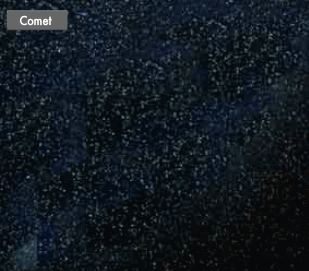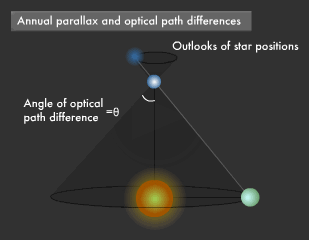Canon Science Lab
Why Do Comets Have Tails?
Comets leave long beautiful tails when they come close to the sun. What is the relationship between sunlight and these tails?
Comets comprise rock, metallic dust, and the frozen dust of volatile materials. They are like dirty snowballs. When far from the sun, a comet is like a stone rolling around the universe. But when it approaches the sun, the heat evaporates the comet's gases, causing it to emit dust and microparticles (electrons and ions). These materials form a tail whose flow is affected by the sun's radiation pressure.
A Comet Has Two Types of Tail
We can observe two types of comet tail that reflect the light spectrum differently. One is a plasma trail, which draws a straight line like a broomstick. The other is a dust tail, which opens like the bristles on a broom. The plasma tail comprises electrons and ions that are ionized by the sun's ultraviolet radiation. The dust tail consists of micrometer-scale particles. The dust tail is wide and slightly bent because of the pressure of the light from the sun and the orbital action of the comet's nucleus.

Light Exerts Pressure
"Light pressure" refers to the pressure on the surface of an object when it absorbs or reflects light. Another term is "radiation pressure." This pressure stems from a change in momentum when a photon hits an object and is reflected. The momentum change acts as a pressure (and you will remember that light also acts dynamically). Photons have no mass (weight), but because they have the characteristics of waves, they also have momentum. The force can be quite significant. The radiation pressure of sunlight on one square meter of the earth is as strong as that from accelerating a one-gram object at seven millimeters per second.

In reality, there is little affect on the earth's surface because of air friction and gravity. But the impact on dust particles in space can be massive. So, the concept has been proposed of fabricating a "photon rocket" that would be propelled using this force.
The Sun Pulls Space Dust
Let's take a closer look at the relationship between light pressure and space dust. We know that, in the earth's orbit, a small particle (dust) of about 0.1 μm ( 1 μm = one millionth of a meter ) in diameter can move toward the sun through a whirlpool motion caused by light pressure. After around 2,000 years, the particle hits the sun. This is called the Poynting-Robertson Effect. One would think that light pressure would blow space dust far away. Why, then, does it approach the sun? This is because the object is moving, so the direction of the pressure from sunlight is different from the actual direction of the sun. The sun's gravity is stronger than the component of the force trying to repel the dust away from the sun.

Our Sense of Light Direction Changes
We know that that the direction of light from a star in space can seem to be changed because of the earth's rotation and revolution around the sun. This is called "phenomenon aberration." Scientists discovered this phenomenon by observing the difference of directions in which stars appear season by season. The position of a star seemingly changes because of the earth's motion, but the light itself goes directly to the earth. Aberration occurs for the same reason that rain seemingly pours down in front of you when you run, yet is actually dropping vertically. It is also known that angles of aberration can be calculated.

